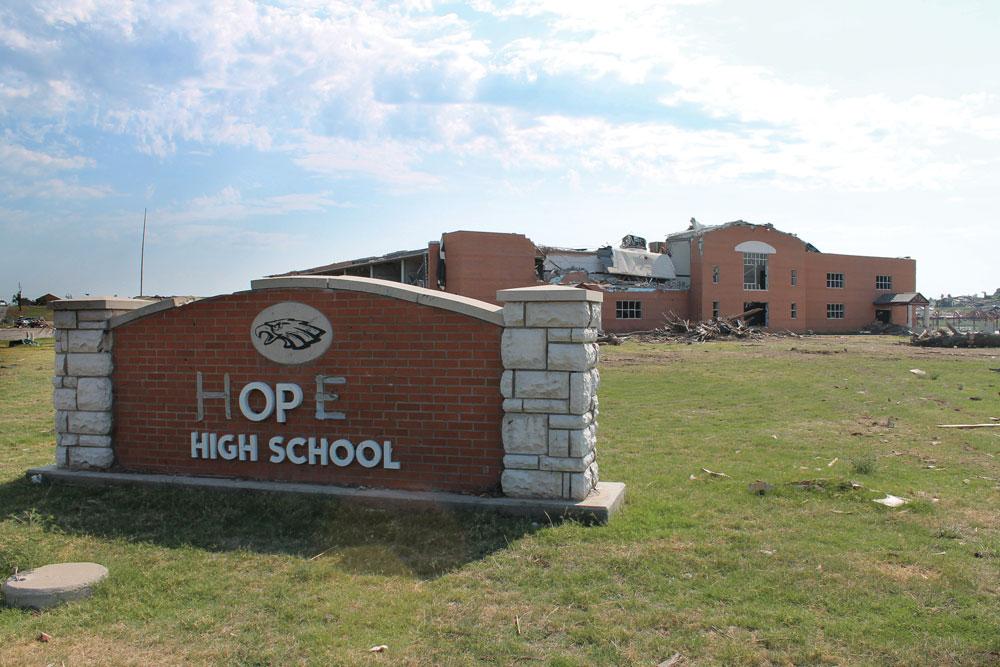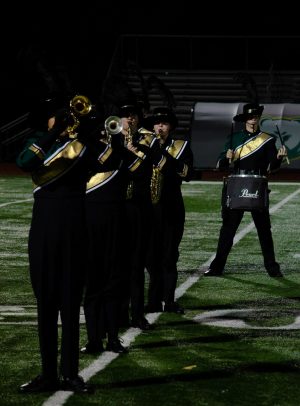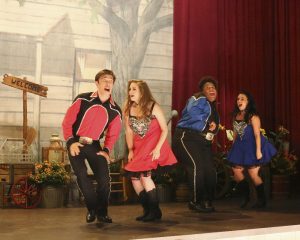4 months after the tornado
Joplin Recovery
On May 22, a merciless EF5 twister, the highest intensity possible, ripped through Joplin, Mo., population 49,000. With scores of citizens dead, millions of dollars lost and an entire town devastated, recuperation has been possible only through the will power and human perseverance of both volunteers and Joplin’s residents.
Joplin students salvage school spirit 4 months after a deadly EF5 tornado ravages their town

The JHS graduation ceremony took place at Missouri Southern State University, where the tornado had no effect. Those who remained at the university survived unscathed. However, the tornado’s path was unpredictable, and many believed they could make it back home without crossing paths with death and destruction.
The calamity changed their lives forever.
“I think the class of 2011 will always remember: they walked out at graduation, ready for the world, ready for a lot of good things to happen in their lives, and many of [their] lives were turned upside down that day,” Kerry Sachetta, JHS principal, said. “One of the graduates said it best: ‘I was getting ready to go to project graduation, stay up all night, have a good time with my friends, be a kid for the last time, so to speak, and I was pressed into action to help save lives in a horrific event.’ And this particular boy also had [Emergency Medical Technician] training. He couldn’t even spend his graduation night having a great time with his friends. He had to grow up real fast, and he did.”
Two of the nearly 160 lives lost belonged to JHS students. JHS junior Christopher Hanshaw’s friend “only had 17 minutes of his life [after graduation]. Like, his life started, went for 17 minutes and then he lost it.”
The hours after the tornado were utter chaos. People ran around, looking through debris for loved ones or finding places to stay. Little had changed by nightfall.
“It was the darkest night I ever slept. You could hear screaming, sirens, helicopters,” Hanshaw said. “It was complete dark. All the power was out. You could hear everyone outside.”
The next morning the power briefly returned, giving Hanshaw an opportunity to charge his phone. During that time he saw several mass texts all saying the same thing, “The school’s been destroyed.”
“I’m like, ‘No way.’ So I walk down to the school — the gym is all kinds of effed up,” Hanshaw said. “Imagine a pillow, and you’re punching into the middle of a pillow, and it’s all indented like that. Imagine that being the gym, and … half of it gone.”
The tornado destroyed the high school and demolished Franklin Technology Center across the street, a building with a similar purpose as the Columbia Area Career Center, providing classes such as culinary arts, graphic arts, welding and car repair.
But the destruction of these buildings was not as monumental as the fact that no one was in them.
“Thank God the graduation wasn’t at the high school,” Hanshaw said.
The district lost an estimated $150 million, yet the schools reopened on schedule, Aug. 17, a day before RBHS.
However, the high school’s destruction left no place to have classes. No other building in town was large enough to accommodate all four grades. And even though the tornado flattened an area seven miles long and one mile wide in places, districtwide enrollment was still 92 percent of last year.
The district decided to split the grades into different buildings. Juniors and seniors found home in an unfinished part of the mall while freshmen and sophomores went to an old building constructed in 1917 for JHS.
Both buildings are three miles apart, yet they still share the same principal, along with many clubs and sports.
“Being in one building is a lot easier, no question about it, so I’m trying to budget my time in a different way,” Sachetta said. “I have nine years of experience in one building, and as busy as that was everyday, I had a pretty good handle on what was going on. But this is a new experience for me. I have to admit that. … [Adjusting to being at two buildings] would be the biggest thing right now, and just getting used to hopefully not feel[ing] like a visitor each time I go into the building.”
The adjustment has been equally strange for students. JHS senior Christina Gates said her classmates transformed completely; students are a lot nicer to each other than they were before the disaster.
“We work together a lot more and a lot better, and also there’s a lot less bullying. We had a major bullying problem in the old high school,” Gates said. “The saying goes, ‘Disasters can bring out the best in people,’ and I really believe that to be true with most of the people that I know.”
Gates even found many changes within herself. She pays more attention to teachers, and she’s more careful with the substances she consumes and her actions. The changes came quickly and at the beginning of the summer.
Her plans with her friends originally included going to Six Flags and “just do[ing] things we probably shouldn’t have, but that just got kind of thrown in the toilet.” She spent her entire summer helping people rather than her normal antics of video games and partying. Gates said she had to grow up quickly.
“I wasn’t quite done being an idiot,” Gates said. But “I just kind of felt like my home was destroyed and I needed to fix it, pretty much.”
JHS student council president and senior Julia Lewis said this idea filled Joplin, and the schools became the focus of many efforts to rebuild because, “the schools are kind of the heart of Joplin.”
Lewis has seen the JHS T-shirts a lot more, not only on students and faculty but also throughout the community. She said students have also been more motivated to represent Joplin.
“The sports teams themselves have brought it upon themselves this year to get better and to push themselves so we that we can go out and we can win for Joplin,” Lewis said. “I also think they want to do well academically so that people can look at Joplin and not just say, you know, ‘Oh, that’s the town that got hit by the tornado,’ but, ‘That’s the town that’s rebuilding. That’s the town that’s working hard academically.’”
However, it has been difficult. JHS was received a donation from United Arab Emirates that gave each student a laptop. Sachetta said the goal is to go the entire year without using paper. Teachers have had to adapt curriculums to this new style.
And although the center for grades 11 and 12 at the mall resembles a normal high school in many ways, there are still differences. Science classrooms must be outside in trailers because of mall regulations preventing fires inside.
“It’s so hard because the teachers don’t yell, like, yelling to get the kids to be quiet and trying to do our assignments,” Hanshaw said. “But the thing is, you can hear every teacher in the building because our walls don’t go up to the roof.”
Under the circumstances, students are mature and cooperative, Lewis said. They are much more understanding and willing to work together.
“My role, that I see as president, is to just be positive, to keep things as normal as they can be … and to give students a way to … [not only] cope with it, and remember it, but also move on and realize that it’s just something that changed all of us forever, regardless of whether you lost your house or lost a car or lost a family member or friend, it changed you,” Lewis said. “Everyone in Joplin has changed forever but moving on from it and becoming a better person from it. I think that’s something that I, as student council president, can help students realize and move on. And that’s kind of our goal as student council this year, and my goal as a student.”
By Avantika Khatri
Local volunteers offer Saturday for recovery effort

She and many others filed into the parking lot at The Crossing Church, 3615 Southland Dr., as the spaces filled with more than 700 volunteers, each with $10, a safety waiver and a big heart. They were preparing to attend the Columbia for Joplin event Saturday, Aug. 27.
Passengers fell silent as the buses started the four-hour journey to Joplin, Mo. There was plenty of time for the travelers to sleep, but not enough to mentally prepare for the experience they were about to go though, Christensen said.
“You see it on the news, and you see pictures, and we’ve all heard about it, but it’s just so different actually being there,” Christensen said. “We literally pulled into town, and you hit one street and from there on it’s nothing, like everything there was completely demolished — it’s just a bunch of house foundations, broken trees, and it’s been [four] months, and it’s still like that.”
On May 22, an EF5 tornado ripped through Joplin, killing at least 160 and destroying hundreds of acres. But the emotional toll was even worse— neighborhoods missing, businesses left in ruins and Joplin Public School buildings struggling to support their frames.
Joplin’s only high school was located in the heart of the damage, with nearly every window blown out, hallways collapsed and a gymnasium crumbled upon itself.
“We passed by the high school, and it was absolutely devastating,” senior Luke Nation said. “You can’t help thinking, ‘What if that was Rock Bridge?’”
Columbia dentist Neil Riley helped organize Columbia for Joplin after hearing the stories about the devastation.
“It was just amazing how people came together,” Riley said. “All of a sudden, we went from 200 or 300 [volunteers] to 700, and it didn’t really matter to me, as long as we gave people a way to go and experience the devastation. We don’t have to go to the other side of the world to do a mission trip. We can do one right here in our own home state.”
Seven buses trekked from Columbia to Joplin, each with different duties. Four ventured to remove debris in neighborhoods, clearing lots and in a park. Two traveled to Joplin South Middle School to clean the surrounding areas. The seventh bus went to Misty’s Mission, which is still accepting donations. Volunteers sorted different items that had arrived.
The volunteers had an eight hour work day in 90-degree heat, dressed in long pants, gloves, face masks and goggles, but helping less fortunate individuals kept them going, University of Missouri—Columbia sophomore Emma Faist said.
“I can’t imagine the fear and how people were feeling when the tornado actually hit,” Faist said. “Going through rubble, you see a bunch of dirt and wood and debris, but then you see something that’s like a Lego piece, and it makes it more realistic that people actually had to deal with this and go through this horrible devastation.”
As the day came to a close, volunteers returned to buses and looked back at their contributions. Sophomore assistant principal and volunteer Dr. Tim Wright said the volunteers’ experience personally touched each of them. What they brought back to Columbia, whether memories or realizations, affected them more than anything.
“I know I was impacted going to Joplin and giving up eight hours of the weekend,” Wright said. “And the experience of going there and seeing it and doing a little bit was much more meaningful than [writing] a hundred dollar check.”
The experience was something to feel good about.
“Those closest to the disaster have the ability to help the most and, being only four hours away, we had the opportunity to help efficiently,” Nation said. “It’s made me want to help more, seeing how easy it was to go down there, and, from what I saw, we were really able to help out.
“And if the opportunity presents itself, I’d like to go down again; there’s still a lot to be done down there.”
By Kaitlyn Marsh
Young musicians band together in Joplin effort

Around the country, grudgingly enthusiastic teenagers trudge out onto football fields for hours at a time to start off the marching band season. Joplin High School marching band students are no different.
Only, they don’t have a band room.
The JHS band lost an estimated $3.7 million May 22, a hit that has been hard to come back from.
A band program cannot exist without music, instruments and equipment, all of which the tornado destroyed. Financially, the school no longer had a band program, junior drum major Taylor Hughes said. But besides the material loss, the band program also lost their home, a symbol, band members said, of the band program overall and an abode in which the musical family grew together.
“The hardest thing to realize was that our legendary band room, the sanctuary of many, was gone,” Hughes said. “It felt like the spirit of our band was in the rubble.”
But it didn’t stay this way for long. The marching band was able to get back to work “through the kindness of strangers,” band parent Carmen Borup said. This aid, in the form of fundraising, donations and support, poured in from many sources, but some have impacted the band more heavily than others.
Two bands in particular were especially dedicated. Little Elm LOBO Marching Band from Little Elm, Texas and Webb City Cardinal Pride Band from Webb City, Mo. devoted their summers to raise more than $250,000 worth of instruments and money to purchase new music and equipment.
Borup said the “Lobos” made the long, 330-mile journey across multiple states to hold a clinic for the recovering band. Their constant correspondence is still spurring the band to do its best.
Businesses have also helped by donating money or services, like Palen Music’s offer to collect, clean and fix all donated instruments.
“The outpouring of caring, of support, of prayers and well wishes has been overwhelming,” Borup said. “In the beginning just knowing that so many people were thinking about us and were behind us was incredibly uplifting.”
With his mother serving as vice president of the JHS Band Boosters, senior color guard member Brandon Nichols has been very aware of what donations and aid have come in.
“The band has gotten assistance from multiple places. [The two bands] have raised so much money for us, collected instruments and just been there for us through all the hard times after the storm,” Nichols said. “If we didn’t have the help [we’ve received], we would have never made this much of a comeback.”
By showing the students how much support they had, the donors and supporters have raised more than just money and equipment — they have raised the determination of the band. The band’s renewed enthusiasm has further aided in a speedy comeback. Nichols said they’re working hard to get the band “back to normal.”
In fact, Hughes said more than the band’s normalcy has returned. The makeshift band room on the stage of an old city building, new donated equipment and massive support from around the country have made the band’s return possible. But this aid has also motivated the band members, and the drum major himself, to perform better than ever.
“It’s incredible as a drum major to have your leadership goal realized,” Hughes said. “I have much more responsibility now, as my actions directly affect the morale of the band.”
The students’ spirits are up. But, like other marching bands, the musicians aim to raise the school’s spirit, too. This is a goal that they will easily accomplish, as the band’s vigorous return to the field will have immense resonance, Borup said.
“To go to a football game and hear the fight song played swells your heart with pride,” Borup said, “and I would challenge a person to find a dry eye in the stadium the first time it’s played.”
The band has become a beacon for hope, attracting attention for the whole community. With participation higher than any previous year, the 160 members of the marching band are eager to recover.
The band is “basically starting fresh with everything,” Hughes said. “And we sound better than ever.”
By Nomin-Erdene Jagdagdorj




















































































